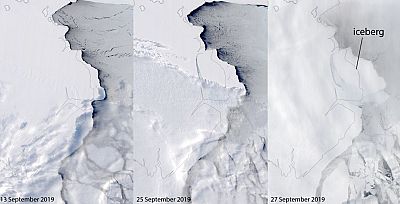Scientists say the calving is part of a natural process, though they worry about shrinking polar ice and the resulting rise in sea levels.
A giant iceberg covering an area larger than Los Angeles has broken away from a floating ice shelf in Antarctica, but scientists say climate change isn't the cause of the ice calving.
The iceberg, dubbed D-28, split off from the Amery Ice Shelf in East Antarctica on Sept. 25, creating a free-floating mountain of ice more than 600 feet thick. The berg covers 630 square miles and weighs an estimated 347 billion tons.
Helen Amanda Fricker, a glaciologist with the Scripps Institution of Oceanography in San Diego, reported the news on Twitter.
Fricker mapped growing rifts in the Amery shelf almost 20 years ago, and predicted that a chunk of ice known as the "loose tooth" would be next to break off. Instead, an even larger area just to the west of the "tooth" is the one that just calved.
"A rift on the other side took off and the iceberg broke away to the west of where we originally thought," she said. "But it looks like that piece might come off as well. … It is not hanging on by much."
Once that occurs, she added, the entire front of the ice shelf will break off. "Probably in another 10 years or so there will be another big calving event from that ice shelf," she said.
For now, the new iceberg is drifting in the waves just a few miles in front of the ice shelf it broke away from. But it could present a navigation hazard for ships as it drifts with the ocean currents and winds. It's expected to drift past one of two Australian Antarctic research bases, one on each side of the Amery Ice Shelf: Mawson Station to the west and Davis Station to the east. "Either way it is going to cause trouble," Fricker said.
D-28 is smaller than the iceberg that broke away from the Larson C ice shelf in 2017, but it could stay in one piece for many months before it drifts farther north and starts to melt in warmer waters.
Although scientists say that climate change is speeding the decline of some other ice shelves and glaciers in Antarctica, the Amery shelf is thought to be calving from natural processes.
"The ice sheet has to maintain its size, and so it has to shed a bit of weight every now and again," Fricker said. "Amery is sort of as stable as they come. We call it the Goldilocks ice shelf — it's not too big, it is not too small, and it is perfectly in equilibrium. We have not seen anything out of the ordinary there yet that we are worried about."
Science
But scientists are worried by the rapid melting of polar ice — and the consequent rise in sea levels. A 2018 study showed that Antarctica's ice sheet is melting three times faster than it was a decade ago, and has lost about 3.3 trillion tons of ice since 1992.
In particular, ice shelves and glaciers in West Antarctica — the region below South America and much of the Pacific Ocean — are showing high rates of thinning and melting.
Stef Lhermitte, a geophysicist at Delft University of Technology in the Netherlands, has been monitoring the D-28 iceberg via satellite photographs. He said scientists had noted a relatively rapid reduction in the size of many glaciers and ice shelves of the West Antarctic region.
"We see more regular calving events, and also smaller icebergs," he said. "That is clearly related to warm ocean water, which could be related to climate change. … With a warmer climate, these things could be more vulnerable."
Want more stories about science?
- An island imperiled: As their home melts, Greenlanders confront the fallout of climate change
- Are we living in a simulated universe? Here's what scientists say.
- A massive raft of volcanic rock could be heading toward Australia. That could be good news.
Sign up for the MACH newsletter and follow NBC News MACH on Twitter and Facebook and Instagram.












